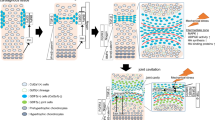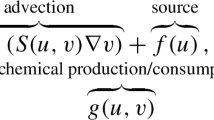Abstract
It has been postulated that fibroblast growth factor (FGF) treatment of cultured limb bud mesenchyme cells reinforces the lateral inhibitory effect, but the cells also show accelerated pattern appearance. In the present study, we analyze how a small change in a specific parameter affects the speed of pattern appearance in a Turing reaction-diffusion system using linear stability analysis. It is shown that the sign of the change in appearance speed is qualitatively decided if the system is under the diffusion-driven instability condition, and this is confirmed by numerical simulations. Numerical simulations also show that a small change in parameter value induced easily detectable differences in the appearance speed of patterns. Analysis of the Gierer-Meinhardt model revealed that a change in a single parameter can explain two effects of FGF on limb mesenchyme cells—reinforcement of lateral inhibition and earlier appearance of pattern. These qualitative properties and easy detectability make this feature a promising tool to elucidate the underlying mechanisms of biological pattern formationwhere the quantitative parameters are difficult to obtain.
Similar content being viewed by others
References
Delannet, M., F. Martin, B. Bossy, D. A. Cheresh, L. F. Reichardt and J. L. Duband (1994). Specific roles of the alpha v beta 1, alpha v beta 3 and alpha v beta 5 integrins in avian neural crest cell adhesion and migration on vitronectin. Development 120, 2687–2702.
Downie, S. A. and S. A. Newman (1994). Morphogenetic differences between fore and hind limb precartilage mesenchyme: relation to mechanisms of skeletal pattern formation. Dev. Biol. 162, 195–208.
Downie, S. A. and S. A. Newman (1995). Different roles for fibronectin in the generation of fore and hind limb precartilage condensations. Dev. Biol. 172, 519–530.
Ermentrout, B. (1991). Stripes or spots? Nonlinear effects in bifurcation of reaction-diffusion equations on the square. Proc. R. Soc. Lond. A 434, 413–417.
Gierer, A. and H. Meinhardt (1972). A theory of biological pattern formation. Kybernetik 12, 30–39.
Gilbert, S. F. (2000). Developmental Biology, Massachusettes: Sinauer.
Hayes, C., M. F. Lyon and G. M. Morriss-Kay (1998). Morphogenesis of doublefoot (dbf), a mouse mutant with polydactyly and craniofacial defects. J. Anat. 193, 81–91.
Lyons, M. J. and L. G. Harrison (1992). Stripe selection: an intrinsic property of some pattern-forming models with nonlinear dynamics. Dev. Dyn. 195, 201–215.
Maini, P. K. and M. Solursh (1991). Cellular mechanisms of pattern formation in the developing limb. Int. Rev. Cytol. 129, 91–133.
Miura, T., M. Komori and K. Shiota (2000). A novel method for analysis of the periodicity of chondrogenic patterns in limb bud cell culture: correlation of in vitro pattern formation with theoretical models. Anat. Embryol. (Berl) 201, 419–428.
Miura, T. and K. Shiota (2000a). Extracellular matrix environment influences chondrogenic pattern formation in limb bud micromass culture: experimental verification of theoretical models. Anat. Rec. 258, 100–107.
Miura, T. and K. Shiota (2000b). Tgfbeta2 acts as an “activator” molecule in reaction-diffusion model and is involved in cell sorting phenomenon in mouse limb micromass culture. Dev. Dyn. 217, 241–249.
Moftah, M. Z., S. A. Downie, N. B. Bronstein, N. Mezentseva, J. Pu, P. A. Maher and S. A. Newman (2002). Ectodermal fgfs induce perinodular inhibition of limb chondrogenesis in vitro and in vivo via fgf receptor 2. Dev. Biol. 249, 270–282.
Murray, J. D. (1993). Mathematical Biology, Berlin: Springer.
Newman, S. A. (1996). Sticky fingers: Hox genes and cell adhesion in vertebrate limb development. Bioessays 18, 171–174.
Newman, S. A. and H. L. Frisch (1979). Dynamics of skeletal pattern formation in developing chick limb. Science 205, 662–668.
Newman, S. J., H. L. Frisch and J. K. Percus (1988). On the stationary state analysis of reaction-diffusion mechanisms for biological pattern formation. J. Theor. Biol. 134, 183–197.
Othmer, H. G. (1986). On the Newman-Frisch model of limb chondrogenesis. J. Theor. Biol. 121, 505–508.
Owens, E. M. and M. Solursh (1981). In vitro histogenic capacities of limb mesenchyme from various stage mouse embryos. Dev. Biol. 88, 297–311.
Ros, M. A., G. E. Lyons, S. Mackem and J. F. Fallon (1994). Recombinant limbs as a model to study homeobox gene regulation during limb development. Dev. Biol. 166, 59–72.
Wolpert, L. (1998). Principles of Development, Oxford University Press.
Author information
Authors and Affiliations
Corresponding author
Rights and permissions
About this article
Cite this article
Miura, T., Maini, P.K. Speed of pattern appearance in reaction-diffusion models: Implications in the pattern formation of limb bud mesenchyme cells. Bull. Math. Biol. 66, 627–649 (2004). https://doi.org/10.1016/j.bulm.2003.09.009
Received:
Accepted:
Issue Date:
DOI: https://doi.org/10.1016/j.bulm.2003.09.009




